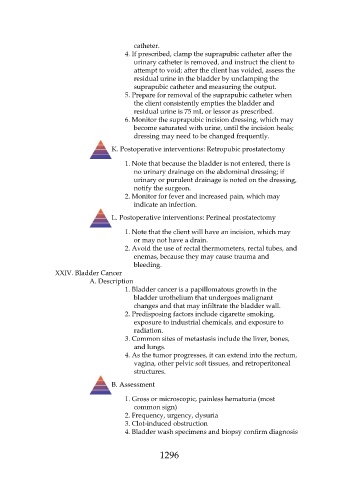Page 1296 - Saunders Comprehensive Review For NCLEX-RN
P. 1296
catheter.
4. If prescribed, clamp the suprapubic catheter after the
urinary catheter is removed, and instruct the client to
attempt to void; after the client has voided, assess the
residual urine in the bladder by unclamping the
suprapubic catheter and measuring the output.
5. Prepare for removal of the suprapubic catheter when
the client consistently empties the bladder and
residual urine is 75 mL or lessor as prescribed.
6. Monitor the suprapubic incision dressing, which may
become saturated with urine, until the incision heals;
dressing may need to be changed frequently.
K. Postoperative interventions: Retropubic prostatectomy
1. Note that because the bladder is not entered, there is
no urinary drainage on the abdominal dressing; if
urinary or purulent drainage is noted on the dressing,
notify the surgeon.
2. Monitor for fever and increased pain, which may
indicate an infection.
L. Postoperative interventions: Perineal prostatectomy
1. Note that the client will have an incision, which may
or may not have a drain.
2. Avoid the use of rectal thermometers, rectal tubes, and
enemas, because they may cause trauma and
bleeding.
XXIV. Bladder Cancer
A. Description
1. Bladder cancer is a papillomatous growth in the
bladder urothelium that undergoes malignant
changes and that may infiltrate the bladder wall.
2. Predisposing factors include cigarette smoking,
exposure to industrial chemicals, and exposure to
radiation.
3. Common sites of metastasis include the liver, bones,
and lungs.
4. As the tumor progresses, it can extend into the rectum,
vagina, other pelvic soft tissues, and retroperitoneal
structures.
B. Assessment
1. Gross or microscopic, painless hematuria (most
common sign)
2. Frequency, urgency, dysuria
3. Clot-induced obstruction
4. Bladder wash specimens and biopsy confirm diagnosis
1296

